Engaged Anthropology Grant: Preeti Sampat
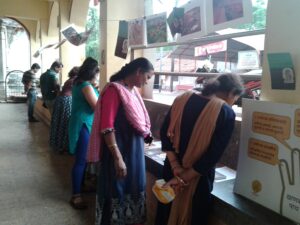
While a doctoral student at City University of New York Graduate Center, New York Preeti Sampat received a Dissertation Fieldwork Grant in 2011 to aid research on “Right to Land and the Rule of Law: Special Economic Zones in India,” supervised by Dr. David Harvey. In 2017 Dr. Sampat was able to build upon her fieldwork when she received an Engaged Anthropology Grant to aid engaged activities on “Living Histories of Land Museum.”
The Living Histories of Land in Goa Mobile Museum initially anticipated large printed mounts curated with visuals of campaign materials from historical environmental struggles in the state such as press releases; posters; news clippings; photographs, excerpts from speeches; and symbolic installations using sound, visual materials and natural materials. After much effort locating materials from older struggles from the 1970’s to 1990’s however, it was clear that largely news media archives and a few pamphlets were available for the older struggles, although more recent struggles had preserved posters and banners. This posed a challenge since a display of mostly black and white press clippings and pamphlets on mounts seemed visually unappealing and would defeat the purpose of attracting bystanders and local residents to the museum venues as it traveled. There was also an imbalance of materials available from older struggles compared to more recent struggles.

After much brainstorming with colleagues to create a visually attractive display, I took the decision to create an installation with an online museum hosted in a dedicated website, that would curate multi-lingual press coverage (in English, Marathi and Konkani) of the struggles, available video archives, and other materials related to the environmental struggles that we could locate. This also put a nice spin on the definition of a ‘mobile museum,’ as the museum could now be ‘visited’ on mobile phones, with a long lasting archive available much after the Museum display period. With the help of curatorial and design assistance, the Museum to put up installations on hired tablets and laptops, curated available videos of struggles into a running loop displayed on a projector screen, and created a short dramatic skit to attract footfall to the venues. Posters and pamphlets from older struggles (where available) and more recent struggles were also put on display around the installation.
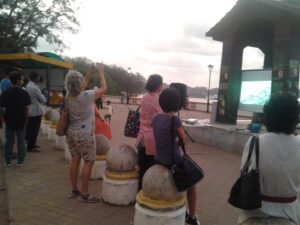
The earliest archived struggle dated from the 1970’s agitations against Zuari Agrochemicals that also catalyzed the Fish-workers movement in Goa and across India. This was followed in the 1980’s by the massive and long-standing agitation against the Konkan Railway; the struggles over controversial tourism projects in coastal areas; and the 1990’s agitations against polluting Du Pont (Nylon 6,6) and Metastrips industries. More recent struggles included those from the mid-2000’s, against the Regional Plan 2011 and 2021; Special Economic Zones; and on-going agitations against mining; the Mopa Airport; the Coal Corridor and Mormugao Port Expansion; and the Declaration of Rivers as National Waterways. While there are many more environmental struggles in Goa, the ones archived and displayed in the museum represented some of the better-known ones in the state.
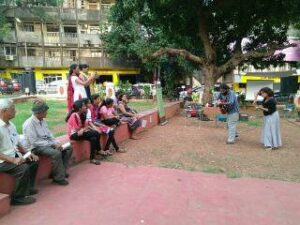
Each of these struggles coalesced in opposition to capitalist development projects initiated by the state, and their implications for local environments, livelihoods and culture. The modes of protest included collective protests on project sites, villages and cities influenced by the project, and the capital city Panjim; as well as legal action by concerned residents. The Museum’s online archive organized the historical archives of these struggles along five key sub-themes emerging from the nature of development projects: infrastructure; industry; tourism; mining and real estate. As the Museum was curated and the archive emerged, the periodization of the struggles also shed light on the shifting dynamics of capitalist accumulation in the state. Despite continuing overlaps, some of the earliest controversies erupted around projects related to infrastructure and industry; followed by tourism; with mining and real estate projects more recently.
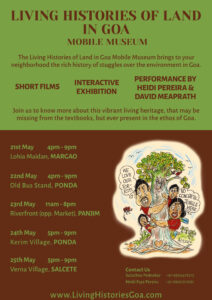
The Museum traveled to five locations across Goa, Margao, Ponda and Panjim cities, and Kerim and Verna villages from June 21 – 25, 2018. The Museum had initially anticipated displays in three venues, but this was later extended to two more, as the costs of transportation and labor were reduced with the lighter, mobile installation equipment. Margao and Ponda cities in South and North Goa districts respectively (Goa has only two districts) were added to the venues. Margao is the center of many agitations from South Goa; while Ponda is close to the villages in North Goa where a number of environmental agitations have taken place; and both are bustling market towns with a number of people from nearby villages visiting for work, leisure or other activities. Since all the venues were public spaces arranged with due government permissions, the theatrical skit was used to introduce the Museum to bystanders and visitors at the Museum venue. This was followed by an invitation to view the original pamphlets and posters from the struggles; and the archival materials on laptops, tablets and mobile phones arranged at the venue. The film screening of short films from various struggles was held in the evening to allow for clearer viewing at dusk and after sunset.
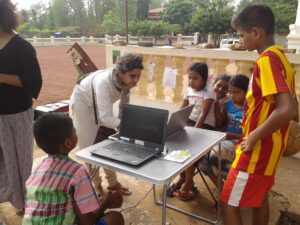
The audience in each of the venues ranged from curious bystanders; local residents passing through; students; local activists; and journalists. For many, this was a novel archival display, a people’s history of the state. Local residents from different villages also extended invitations for hosting the Museum in their localities in the future. The Living Histories of Land in Goa Mobile Museum hopes to continue adding to the online archive with support from volunteers and to travel to other locations in the future. With the positive feedback and interest the Museum generated, discussions to this effect have been held with interested activists.